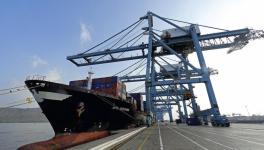Why Labour from Lower Wage East European Countries is Moving Westward
Representational use only.
The relocation of capital from the advanced capitalist countries of the North to low-wage countries of the South in the current era of globalisation has received much attention. But, there is another kind of relocation that has not received as much attention, and that is of labour from comparatively lower-wage countries of Eastern Europe to the advanced capitalist countries.
In fact, since within the European Union there is generally free mobility of labour, this has become a powerful inducement for these Eastern European countries to join the European Union. Some of these countries have started displaying certain classic symptoms of labour-exporting economies: declining absolute populations; a shift in the composition of the population from able-bodied males of working age, to women, children and older people; and a change in the character of the economy from being productive to being remittance-receiving. The collapse of the Soviet Union has been followed by a tendency toward depopulation of the countries that constituted its western segment.
In Bulgaria, the population declined by 11.5% over the last decade, from 7.3 million to 6.5 million. In Romania the population was 23.2 million in 1990 but declined to 19.4 million, i.e., by 3.8 million or 16.4%, by 2019. Latvia had a population of 2.38 million in 2000 which had fallen by 18.2% to 1.95 million by the beginning of 2022. The decline in population in Lithuania and Georgia is of a similar order of magnitude over a comparable period. Ukraine is estimated to lose a fifth of its population between now and 2050.
This decline is not confined only to former Soviet republics; it afflicts countries that constituted former Yugoslavia as well. Since the collapse of Yugoslavia, Bosnia and Herzegovina has lost 24% of its population, Serbia 9% and Croatia 15%. Such declines also characterise Albania and Moldova.
In fact the top 10 countries in terms of population decline are all from Central and Eastern Europe; and seven of these 10 countries have been inducted into the EU. The most important reason for the decline in population obviously is migration to the West.
Of course, this is not the first time that capitalism has witnessed a relocation of capital and labour within the domain it controls. On the contrary, there has been such relocation in every phase of capitalism, except that the patterns of relocation in the different phases have been different.
In the period before the mid-19th century, the relocation of labour took the coercive and cruel form of the trans-Atlantic slave trade. From the mid-19th century, until the First World War, the relocation of capital took the form of European investment in the “new world” that contributed to a massive diffusion of capitalism (it was financed largely by the “drain of wealth” from the colonies).
The relocation of labour over this period took two different forms, one was the migration of European labour to the “new world” (the temperate regions of white settlement) that was complementary to the migration of capital, the other was the migration of Indian and Chinese labour to the tropical and semi-tropical regions of the world (though such migration of tropical or semi-tropical labour was strictly forbidden to the temperate regions).
In the post-War period, there were strict capital controls in force and hence relocation of capital was for specific purposes, such as “tariff-jumping” to enter the protected Third World markets (or mutual investments within the advanced capitalist world); but relocation of labour took the form of the migration of labour (in controlled numbers) from ex-colonies or dependencies and satellites to the metropolis, such as from India, Pakistan and the West Indies to England, from Algeria and Morocco to France, and from Turkey to Germany.
The current period, by contrast, has seen a notable shift of capital from the metropolis to the Third World and the migration of labour from Eastern Europe to the advanced countries. The chief motivation for both shifts from the point of view of capital has been the quest for cheap labour.
Ironically, “mainstream” bourgeois economics does not even recognise the relocation of capital and labour. In fact, it sees the reason for trade in goods and services in this absence of relocation of capital and labour. A country where there is more capital per unit of labour, since it cannot export capital to another country with less capital per unit of labour, is supposed to do the “next best thing”, which is to export capital-intensive products to the latter and import labour-intensive products in exchange. In fact this explanation of trade-patterns, through an absence of relocation of capital and labour, plays an apologetic role.
If “mainstream” bourgeois economics recognised that relocation of capital and labour occurred under capitalism, then it would be forced to explain the trade in products in some other way (not as a proxy for the relocation of capital and labour); and this other way inter alia would be trade on the basis of what was geographically possible to grow in particular regions. This would mean that regions that are unwilling to trade though they grow commodities which the other region badly needs would have to be “opened up” for trade. It would entail, in short, facing the phenomenon of imperialism. It is this which is prevented by the apologetic trade theory of “mainstream” bourgeois economics.
Britain, for instance, was the country that pioneered the industrial revolution, starting with the cotton textiles industry. But Britain cannot grow any raw cotton, because of which the industrially pioneering country would need control over distant tropical and semi-tropical lands that can produce raw cotton and get them to supply the quantities it needs.
Thus, once we move away from the fairy-tale of trade occurring in accordance with “factor endowments” in a situation where the factor endowments themselves were supposedly frozen and could not migrate across country-borders, then “imperialism” becomes impossible to ignore. “Mainstream” bourgeois economics does precisely this: it ignores imperialism and explains trade as the result of capital and labour not being traded or relocated.
Since West Europe itself has been afflicted by high unemployment rates, the phenomenon of immigration into it from its lower-wage eastern neighbours may appear intriguing at first sight. But migration does not occur only into regions and countries that are experiencing labour shortages.
In a world characterised by unemployment everywhere, there would still be migration from low wage to high wage regions for two reasons: one, the motive for migration is provided by the expected income one can earn compared with one’s current income, which already takes into account the possibility of unemployment; and, two, migrants are usually willing to work at somewhat lower wages (or worse conditions of work) than the local population, so that their prospects of employment tend to be better than those of the local population. This explains the paradox that even a crisis-afflicted western Europe can draw immigrants from eastern Europe which has been witnessing virtual stagnation since the collapse of socialism.
The twin phenomena associated with contemporary globalisation, of migration of capital from the metropolis to parts of the Third World, and of migration of labour from the erstwhile Second World to the metropolis, have the effect of weakening the working class movement everywhere. These phenomena weaken it in the metropolis; they also weaken it where capital migrates (for otherwise it would choose a different destination). They also weaken the position of the migrant workers, whose employment prospects depend precisely on their not being organised. At the world level, there is thus a shift in the balance of class power from the working class to the capitalists.
This, however, only accentuates the crisis faced by capitalism. The net result of the relocation of capital and labour is to raise the share of surplus in world output, which reduces aggregate demand, since a higher proportion of the working people’s income is spent on consumption than of the economic surplus. The irony of contemporary capitalism is that the fanatical quest for lower labour costs has brought the system to the impasse of a protracted crisis.
Get the latest reports & analysis with people's perspective on Protests, movements & deep analytical videos, discussions of the current affairs in your Telegram app. Subscribe to NewsClick's Telegram channel & get Real-Time updates on stories, as they get published on our website.
























